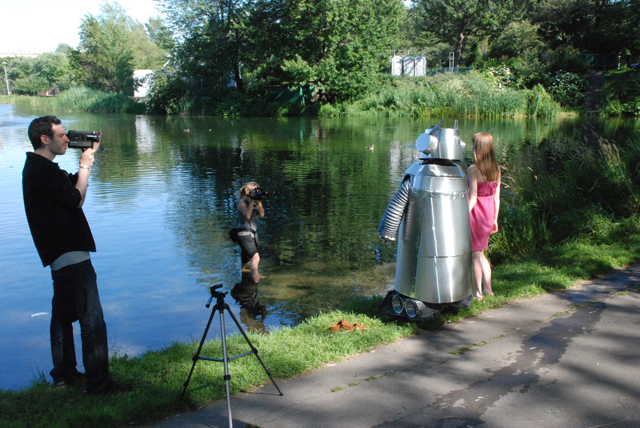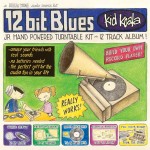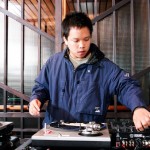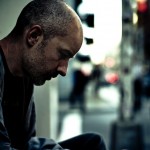
[Photo by SekondHandProjects]
By Max Willens
Remember when hip hop was heavy–when DJ Shadow built neck-snapping beats for Solesides; when the Dust Brothers made a B-boy out of Beck; and when Led Zeppelin, the Clash and Black Sabbath walked that-a-way in the span of one Beastie Boys song (“Rhymin’ and Stealin'”)?
We barely do, either; probably because rap metal ruined the whole turntables-and-guitars thing for a good five years. Enough to make 100%, the Slew‘s debut album (available digitally here)–a scratch-heavy collaboration between Dynomite D and Kid Koala–seem like a left-field listen, what with all its booming basslines and devastating drum breaks. A very heavy affair indeed, especially the duo’s tower of power tour, a one-time-only trek featuring six turntables (with Koala’s longtime touring partner DJ P-Love stepping in for Dynomite D) and Wolfmother’s former rhythm section, bassist/keyboardist Chris Ross and drummer Myles Hesketh.
Kid Koala spoke to self-titled the night before the Slew’s first proper show in Vancouver.
self-titled: Let’s start with a slightly controversial question: The Slew wasn’t really a documentary soundtrack, was it?
[Dynomite D and I] had already talked about making a rock record together. Because he lives in Seattle and I live in Montreal, it was hard to schedule things until the prospect of it being a soundtrack became a semi-reality. It wasn’t commissioned–some bro going, “Hey guys! D’you wanna…” [Laughs] So we didn’t get it licensed, but it served as a catalyst, and quickly evolved from that.
I only ask because the beginnings of some Slew songs (“It’s All Over” and “Southeast Soliloquy”) are also on Your Mom’s Favorite DJ.
We’ve been working on this album for four and a half years now. We wanted to make an album that, in our mind, would appeal to Black Sabbath fans as much as Public Enemy fans, y’know? But the project became much more than that. [We thought] ‘We should cut custom vinyl!’ It was a very time-consuming process, multiplied by the fact that we’re in two different cities, and it was hard for me to get to Seattle for extended blocks of time.
It’s so much heavier than anything else you’ve ever made. Were there points of reference that you were jumping off of at all?
We just wanted to make something that out skater friends would like! [Laughs] And I will say that the foundation of all that came from Dylan (a.k.a. Dynomite D). I was basically recruited for turntable duties, minor arrangements and stuff, but the point where we met was in blues. That’s the thing with hip hop and rock: you take two steps back, and you kind of end up in the blues, and we just took a step back and realized that we were both headed for the same place. That was a bit of a focal point. As far as where our two worlds and interested came together, that’s what was fun about it. I think we work really well together.
You guys have worked on some very disparate, weird things over the years. You made that Free Design track (“An Elegy”) and also “Third World Lover” (from Bombay 2: Electric Vindaloo). I think that this is one of the most focused things you’ve ever done, though.
Yeah.
I mean, not to say that your earlier work wasn’t…
No, no, I get what you mean. Focused would definitely be the word here. We were always asking ourselves, “What would it sound like if Hank Shocklee and the Bomb Squad produced Black Sabbath? Or what about if the Dust Brothers did?” So what we focused on were these kind of hand-cut, choppy vibes. But we also liked how heavy the beats were in both genres, so it really became kind of a mantra for us [Laughs]: “What would Hank Shocklee do?” We made a lot of decisions based on that. We studied up on how rock records were made, we treated the turntables the same way, even plugging the turntables into amps at one point and overdriving them, just because it makes you play differently when you’re in a band, which I’m really realizing now, after having done rehearsals for this show.
Tell me about how you met the Wolfmother guys (who quit that band in 2008 and now play in Palace of Fire), and what effect the rehearsals have had on the songs themselves. I’m sure they’re even punchier and heavier than they are on record…
Oh yeah. Well, on record you’re reacting to yourself [laughs], because you’re laying down every layer, and everything is timed. Whereas in a band, something you do is going to inspire something else in the group to do something, and the energy’s going to get passed around that way, and that more organic style opens things up.
As far as meeting them, I was on the guest list for their first Seattle show, and it turned out they didn’t have a lighting guy. [Laughs] So Dylan did lights for them at their first Seattle show. Afterwards he met Myles and Chris and they hit it off, so he called me and told me to check them out when they came to Montreal. And the day they were scheduled to play, I was walking by the venue in the afternoon, and there they were, standing outside [laughs]. So we started talking about keyboards, and I told him there’s some great vintage keyboard shop in this town, so we hit it off that way.
We kept in touch, and every time we crossed paths, they would ask, “Hey, what’s up with the Slew? When is that going to be finished?” And so when me and Dylan were thinking about how to present the album live, we were running through things and said, “Okay, so technically, we’re going to need seven DJ and 15 turntables.” [Laughs] But then we were like, “That’s not gonna look very rockin! We should just have a live rhythm section; that would be perfect.” At that point, Dylan was just like, “Why don’t we ask them?” And we’re very lucky that they’ve been able to come do this with us, because they’re in the studio with their new album right now.
Because of the logistics involved, this is probably going to be the only Slew tour. What’s the mindset like, knowing that you only get to try this once?
We had a relatively short period of time between when Chris and Myles said, “We’re free in this window of time,” to actually booking and rehearsing to now, where we’re in Vancouver and the tour starts tomorrow night. Within that three-month period there was a lot of pre-production. Like I needed to do cut all the show vinyl. We knew we’d be approaching it differently from when P-Love and I normally tour together. We knew it’d be more of a rock thing, so it wasn’t so much about being on eggshells and being on your toes and really precisely cueing up records. It was about dropping the needle and digging in right away, right off the top.
So we said, “We need to make special records that we can quick-cue; we need to make special records that aren’t going to skip; we should make a special stand that’s not prone to space feedback…” Basically something where we can be jumping around and not have the normal list of issues that you have when you’re DJing. We did all this R&D into special stands, foam and gel, all these absorptive layers, basically just to prepare…
…for the mayhem that was gonna ensue?
Exactly. So Pablo and I ccut like 80 show records, and we had to learn the cues, the rotations, that stuff. And after that, Chris and Myles came up and we moved into a rehearsal space, plugged into amps. For this project, we knew what kind of freedom we wanted and what we needed to make that happen. Like, we have one record that’s just an E chord on an organ for eight minutes. That way, we can just throw it on, and we don’t have to waste any time, we can just go. This way, it’s more fluid.

Here’s a random question: What’s up with the live-action Nufonia stuff you’ve posted about on your blog?
We kind of did that on a dare. [Laughs] We were just sitting around and said, “Alright, let’s see if [my comic book art is] any more entertaining in live action, rather than black and white illustrations.” So we just got a crew of people and were running around Montreal, doing little scenes. It was very fun, very guerrilla-style filmmaking. That’s in editing right now; we don’t know what’s going to happen with it, but if the results turn out funny, we might do more of them.
It seems like artists just do whatever the hell they want, whenever the hell they want up in Montreal.
[Laughs] Well, in the winter, you can’t suntan. You could, but you’d freeze to death. I dunno, it’s a small city in a big village. So if you think, “Hey do we know anybody who, uh…”
…can build a giant tin robot?
Yeah, whatever it is, if you put your heads together, you can probably find a squad of people who’ll be down to go out and make something. It’s an attitude that is very Montreal. I mean, as far as its reach afterwards, that’s another story, but in the moment it’s like, “Yeah, this’ll be fun!”



